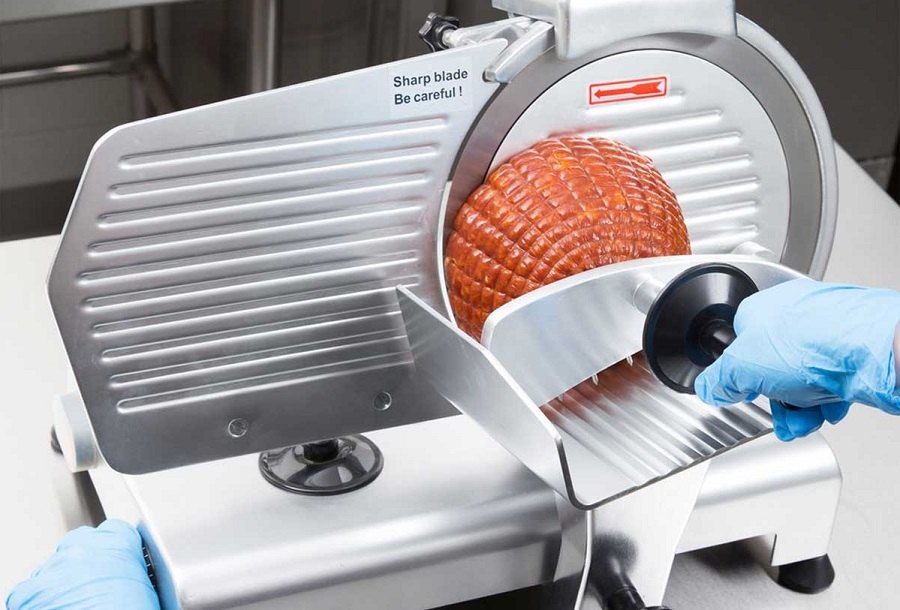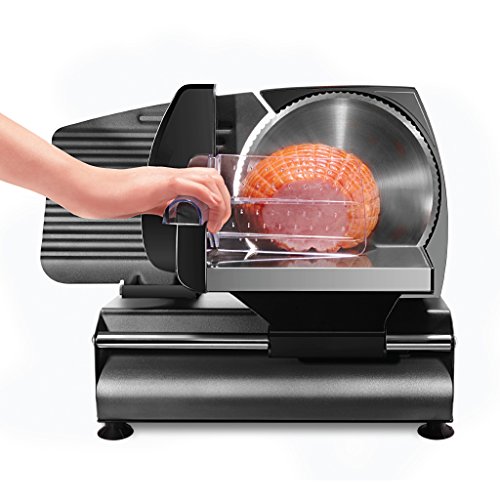To purchase or not to purchase a meat or food slicer is often a perpetual dilemma for a lot of homeowners. It may not be something you will buy right off the bat or categorize as an essential item for the kitchen; however, this incredible equipment can make your whole kitchen experience much more straightforward and comfortable.
In This Article You Will Learn...
What Is A Meat Slicer?
Meat slicers, also known as deli slicers, slicing machines, or just slicers, are powerful tools used in delis and butcher shops to slice meats, cheeses, sausages, and many other deli products.
Many old meat slicers are crank-operated; however, newer products usually have electric motors integrated. Although meat slicers are traditionally considered commercial apparatus, nowadays household versions are also available in the market.
There are two main reasons why a meat slicer is excellent for household use. Firstly, a good slicing machine can release the textures and tastes of meat much better compared to what hand-cut and thick slices can do.
Secondly, a meat slicer can save you plenty of money. That is because sliced meat from most supermarkets and delis may cost up to three times higher than unsliced beef.
Instead of seeing hand-cranked or manual slicers as a drawback, many chefs contend that top-notch manual machines are better than their electric counterparts. That is because manual slicers can cut thinner slices of meat than electric slicers. Besides, as their blade turns much slower, it produces less friction and heat that could affect the taste or flavor of the food item you are slicing.
You could easily buy a meat slicer for less than $100; however, a majority of models often fall in the price range of $100 to $400.On the other hand, a commercial slicing machine can easily cost you thousands of dollars, but they are overkill for people looking for a household meat slicer.
Expensive models usually provide either higher-powered, electric motors that can work much faster for extended time periods or have a large size and can accommodate more kinds of food.
A lot of new meat slicers feature high wattage, powerful motors capable of slicing meat faster and much more efficiently. Moreover, motor’s power also affects how long you can slice meat or food. Many meat slicers would quickly overheat and require a break to cool down before the user can continue.
For customers who need a meat slicer just for making sandwiches once or twice a week overheating will not be a serious issue. However, for those who intend to do plenty of slicing on a frequent basis, it may soon become a nuisance.
The term “meat slicer” or simply “slicer” is usually used interchangeably with the term “food slicer." That is why a lot of people often think meat slicing is the only use of a food slicer. But that is not true. You may use your meat slicers to slice a variety of food items.
Meats, vegetables, cheeses, fruits, and pieces of bread are only the start. Some meat slicers are very useful for foods that need unusually thin slicing such as potato chips, sliced onions for that perfect salad or sauerkraut.
Types Of Meat Slicers
A meat slicer can be one of the most useful machines in your kitchen or restaurant as it can slice various foods more uniformly and evenly than can be achieved by hand. There are several different kinds of slicing machines available in the market with a slew of options; however, they have two main types which are manual meat slicers and automatic or electric meat slicers.
Automatic Meat Slicer
An automatic meat slicer often called an electric meat slicer, is what you will often come across when you search for a meat slicer. These meat slicers dominate the market due to several reasons. They are very simple to use and affordable, making them the most popular option for home and commercial users. They also reduce waste and improve efficiency.
As the name indicates, automatic meat slicers use electricity to do most of the work, saving you both time and effort. An automatic slicer includes an electric motor to move the carriage; therefore all you have to do is place the food items you want to be sliced on your electric slicer and turn it on.
Another benefit is that a majority of automatic meat slicers could be switched to a manual mode in case you want to slice meat that way to have greater control occasionally.
Higher-powered electric slicers are particularly useful for people who intend to slice plenty of frozen meats or cheese. These are often some of the most challenging tasks for any meat slicer to pull off. So, if anyone of these two will be your primary task for the slicer, it is better to invest in a high-quality electric version with lots of power.
Manual Meat Slicer
On the other hand, a manual meat slicer needs a person to move the carriage or food to complete slicing manually. As a result, these slicers require more effort and tend to be much slower to use compared to electric models. Manual meat slicers are not a practical option for people who use their meat slicer frequently for slicing meat in bulk or high volume.
Previously, they were the go-to machines for meat slicing; however, since the advent of automatic or electric meat slicers, their popularity has plummeted. That is why manual meat slicers are a little harder to find than automatic ones.
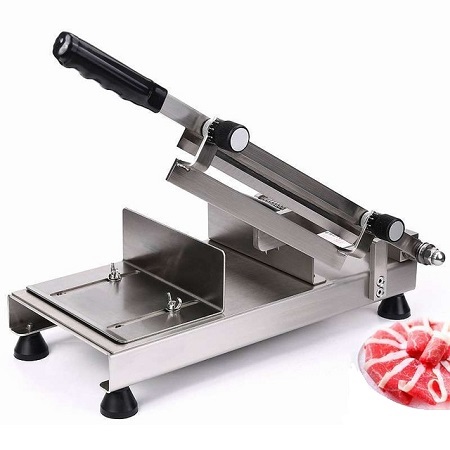
Nonetheless, many folks still prefer the additional control manual meat slicers offer and think that meat slices usually come out with a better flavor and texture when using manual slicers than automatic models. Manual models are also cheaper than automatic ones.
Whether you require a heavy duty or light duty, automatic or manual meat slicer, it is always essential to keep safety and sanitation in mind when buying the product.
Parts Of A Meat Slicer
There are integral parts of a meat slicer you should familiarize yourself with - especially if you require a mid-level, entry-level, or heavy-duty meat slicer.
Blades
The obvious and probably the most critical part of a slicing machine is its blade. Keep in mind that the blade size can vary between mid-level, entry-level, or heavy-duty meat slicers. There are two main types of slicer blades: serrated and fine edge blades.
The evident difference between the two is that fine edge blades have a smooth edge; in contrast, serrated slicer blades often resemble a table saw. Both kinds of slicer blades are usually multi-purpose; however, for a lot of slicer models that feature serrated blades, manufacturers typically provide an extra straight edge blade that helps with ultra-thin slicing of products such as specialty meats like prosciutto.
Many manufacturers also offer a spare serrated-blade for professional or large slicers that usually have a standard fine edge blade. A serrated-blade tends to do much better when slicing fibrous foods or hard crusted loaves of bread.
Gauge Plates
The gauge plate surrounds the slicer blade and allows the users to adjust slicing thickness. The gauge plate is made of steel and can cost between $100 and $250.
Pushers
It is used to hold the product such as meats or cheeses, in place as the blades slice it. A "pusher" is also called a meat grip and is inside the product-table. For quick cleaning, various designs feature removable pushers.
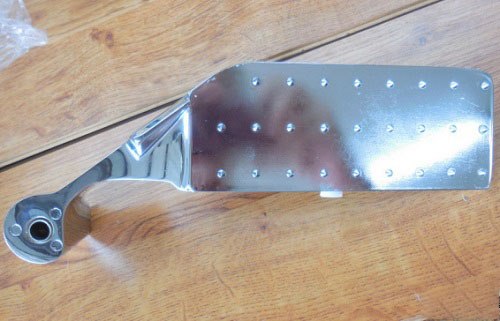
Product Trays
A product tray is for keeping meat and other ingredients for slicing. The blade guard is in-built in latest meat slicer products. It helps protect users against severe cuts, ensuring a safe slicing experience.
Kickstand
You will find a kickstand-style leg on some models of meat slicers. It helps users prop up the machine for easy cleaning
Blade Sharpener
Most commercial meat slicing machines have a built-in blade sharper that keeps the slicer blade razor sharp to deliver the best results.
Meat Slicers Pros
Although cutting meat with a sharp knife is excellent, slicing it with your meat slicer is often better as it helps split the chicken or pork into equal and thick parts that would look great on the final presentation. These are some of the main reasons you will enjoy slicing meat with a slicing machine instead of your knife.
More Economical
One of the main benefits you could derive from using a slicer is that you can save a lot of money that you would have otherwise spent on buying sliced meat from your local grocery store. Sliced beef is quite expensive compared to buying a big loaf of meat you can slice at home.
Ease Of Cutting
The incredible comfort with which users can cut meat into beautiful slices is another significant advantage of having a good meat slicer by your side. Cutting meat with precision into tiny slices of the same size is made more straightforward and less time-consuming with an efficient meat slicer.
Frozen proteins, roasted meats, and more substantial chunks of meats can all be easily cut without any stress if you are using a meat slicer.
Keep The Quality Of Meat Intact
Meat slicers will chop, grind, and slice your meat perfectly without adversely affecting the quality of your meat. The taste, quality, and texture of your meat will remain intact after getting sliced or chopped.
Save Time
Slicing or grinding meat often takes plenty of time and effort. However, meat slicers perform this job much quickly and efficiently. That can help you save time spent cooking in the kitchen. Whenever you need to make a non-vegetarian or vegan dish, you could use your slicer to cut meat or vegetables into slices of suitable size and prepare your meal much faster.
Meat Slicers Cons
Meat slicers have a few drawbacks which are:
Cleaning
Keeping a food slicing machine sterile and clean is imperative. Skimping on regular cleaning may cause many food-borne illnesses, and you will like to keep them at bay. All meat slicers need a little cleanup time; however, some require more time and work than others. Most modern models have to be taken apart for thorough cleaning, and this is why disassembling and reassembling a slicer can be a tedious job.
In contrast, meat slicers that do not have removable parts will often have you scrubbing or cleaning spots in tricky corners and crevices, which is not fun as you will have a harder time getting it perfectly clean.
Safety
As meat slicers have sharp, large blades that can move at incredibly fast speeds to perform their job, they indeed pose a safety risk to users. Also, meat slicers which are difficult to take apart or very heavy are more likely to give you a nick or cut during cleaning or handling in case you are not careful.
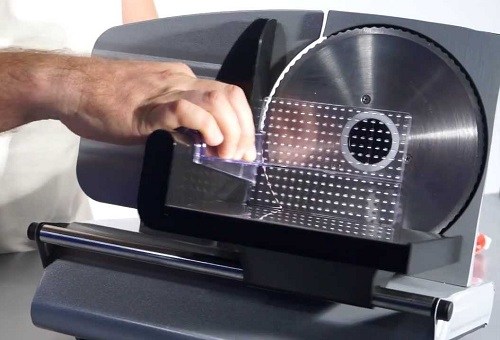
How To Use A Meat Slicer?
With the following steps you can use a meat slicer efficiently and safely:
- Thoroughly wash your hands before use and dry them. To keep your food sanitary, put on a pair of gloves
- Lift the slicer’s clamp arm and gently pull it away from your slicer
- Put your meat on the slicer carriage and pull the clamp back toward the surface in a downward direction. That will help hold your meat securely in place
- Use the adjusting knob to select the preferred thickness of the meat slice
- Slide a deli tissue or piece of wax paper at the bottom of your meat slicer to get sliced meat
- Then turn on the switch and push the carriage handle to move your bulk meat to the rotating blade
- It is better to cut a single sample slice to ensure the desired thickness. If needed, adjust the dial to get thicker or thinner slices
- Rock the slicer carriage back and forth with one hand and use your other hand to prevent the slices of meat from dropping on the paper
- Remember to switch it off immediately after using the meat slicer and unplug it
- Store the sliced meat in a dry place where there isn't a lot of moisture, and wrap any leftover bulk beef using plastic wrap
- Carefully wipe down your slicer, including its bottom level, carriage, and blade
Safety Features
When you are looking to buy a powerful piece of equipment that is operated with hands and utilizes razor-sharp spinning blades to slice meat and other products, it is hard to over-stress the importance of buying a product that is safe. Besides, adequate training is essential for any person who will operate the meat slicer.
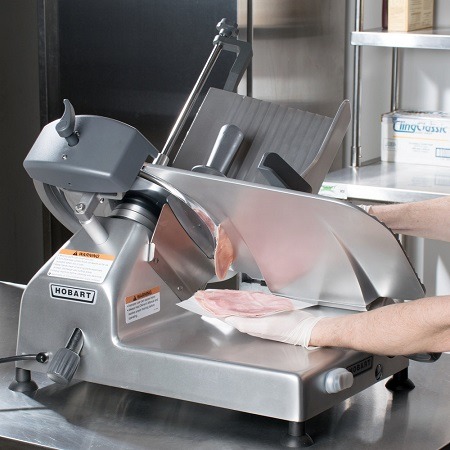
The good news is that most modern meat slicers have a variety of safety features that can help alleviate users’ safety concerns.
Knife Guard
Usually, all meat slicers made in a way that exposes the blade as little as possible, to prevent users from cuts and nicks. Many slicers allow you to remove the knife guard to clean the blade or knife, while on others it cannot be removed.
Gauge Plate Interlock
It is a safety feature that requires the user to set the gauge plate at "zero," so they can safely remove or tilt the slicer carriage or tray for cleaning.
That protects not only the operator's fingers but also the blade's edge!
No-Volt Release
It is an important safety feature that requires you to push or press the power button to restart the meat slicer if it was unplugged for cleaning and maintenance, or in case the power was interrupted.
How To Clean Your Meat Slicer?
As meat slicers are used to slice a variety of food items such as meats and cheeses on a regular basis, it is vital to clean them often. If you don't wash your meat-slicer frequently, it will lead to a lot of problems - such as bacterial growth.
All those pieces of meat and other ingredients will end up sticking on the blades. The bacteria may contaminate your food and trigger food-borne illnesses. Follow these steps to keep your slicer squeaky clean.
Always put on a pair of protective gloves before cleaning. Cut-resistant gloves such as those made of cut-proof metal are the best option, mainly when handling or cleaning the blade.
Carefully follow the manufacturer's directions for cleaning and avoid using steel wool as it may scratch your machine.
Set the thickness level to zero and with a scrub pad gently wipe each side of the slicer blade while the machine is in motion. After removing large food-particles, turn off your slicer and unplug it.
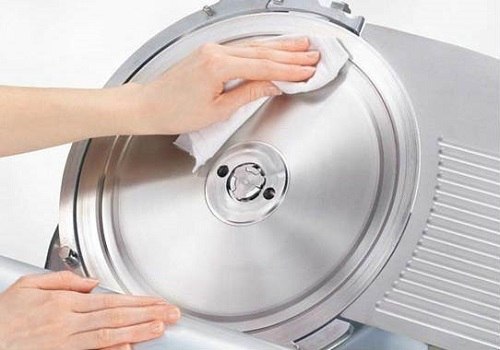
Then ensure the slicer's gauge plate is closed, and the sharpening tool is not in the way. Now remove the slice deflector, product tray, and center plate. Wash and rinse these parts thoroughly, letting them air dry.
To sanitize the slicer blade clean it with a soapy solution containing equal parts soap and hot water. Alternatively, you may use a degreaser spray for polishing the edge.
Now wipe down all the remaining pieces and the exterior of your meat slicer. Rinse them with hot water.
Use a meat slicer sanitization spray to sanitize the appliance. Coat your machine thoroughly with a spray bottle and let it air dry.
Finally, lubricate all slide rods with a good spray lubricant. When your meat slicer is thoroughly dry, replace the faceplate, blade, and tray.
Never submerge your meat slicer entirely in water or any cleaning solution. The slicer's instructions manual will tell you which components are dishwasher safe.
Meat Slicer Repair Tips
As the leading components of a meat slice are meat slicer a motor and blade, only a few things could go wrong. Often, accumulation of food residue or a dull-blade are the culprits behind many meat slicer problems. Gears and blades may get damaged, or the power switch, cord, or motor could be faulty. Many signs indicate your meat slicer is not working right such as:
- It slips during use
- It makes excess noise during operation
- The food tray does not slide in easily or smoothly
You will need the following tools to disassemble and repair your meat slicer:
- Screwdrivers
- Petroleum jelly
- Glass cleaner or denatured alcohol
So, here is how we going to do it:
Unplug your meat slicer’s electrical cord before disassembly.
Loosen all the screws and gently tap the slicer blade from behind. Remove all the bolts and lift the slicer-blade carefully.
Then remove the product tray by gently tipping your meat slicer over on its motor and pry the product tray off the rails.
With one hand support the slicer's engine loosen its retaining screw and slide the motor carefully away from the head of the slicer.
Remove the remaining screws to separate the two halves of your motor housing. That will expose the motor, pinion gear, and off-on switch.
Make a careful and comprehensive examination and replace or fix any damaged or broken parts. These parts can include the power switch or the gear.
Then carefully reassemble all the components after lubricating all the sliding and moving parts.
Conclusion
We have discussed what a meat slicer is and how it operates. We have covered two main types of meat slicers which are manual and automatic and why the electric models have become popular. We have discussed the various parts of a meat slicer like the blade, pusher, product tray and gauge plate. We have highlighted the main benefits and drawbacks of using meat slicers.
We have provided step-by-step instructions on how to use and clean a meat slicer. Various safety features present in meat slicing machines are also comprehensively explained. We have provided tips on how to identify issues with your slicer and repair them. Our buying guide will discuss the different features that you should consider when buying a meat slicer along with some recommendations.
To purchase or not to purchase a meat or food slicer is often a perpetual dilemma for a lot of homeowners. It may not be something you will buy right off the bat or categorize as an essential item for the kitchen; however, this incredible equipment can make your whole kitchen experience much more straightforward and comfortable.
What is a Meat Slicer?
Meat slicers, also known as deli slicers, slicing machines, or just slicers, are powerful tools used in delis and butcher shops to slice meats, cheeses, sausages, and many other deli products. Many old meat slicers are crank-operated; however, newer products usually have electric motors integrated. Although meat slicers are traditionally considered commercial apparatus, nowadays household versions are also available in the market.
There are two main reasons why a meat slicer is excellent for household use. Firstly, a good slicing machine can release the textures and tastes of meat much better compared to what hand-cut and thick slices can do. Secondly, a meat slicer can save you plenty of money. That is because sliced meat from most supermarkets and delis may cost up to three times higher than unsliced beef.
Instead of seeing hand-cranked or manual slicers as a drawback, many chefs contend that top-notch manual machines are better than their electric counterparts. That is because manual slicers can cut thinner slices of meat than electric slicers. Besides, as their blade turns much slower, it produces less friction and heat that could affect the taste or flavor of the food item you are slicing.
You could easily buy a meat slicer for less than $100; however, a majority of models often fall in the price range of $100 to $400.On the other hand, a commercial slicing machine can easily cost you thousands of dollars, but they are overkill for people looking for a household meat slicer. Expensive models usually provide either higher-powered, electric motors that can work much faster for extended time periods or have a large size and can accommodate more kinds of food.
A lot of new meat slicers feature high wattage, powerful motors capable of slicing meat faster and much more efficiently. Moreover, motor’s power also affects how long you can slice meat or food. Many meat slicers would quickly overheat and require a break to cool down before the user can continue. For customers who need a meat slicer just for making sandwiches once or twice a week overheating will not be a serious issue. However, for those who intend to do plenty of slicing on a frequent basis, it may soon become a nuisance.
The term “meat slicer” or simply “slicer” is usually used interchangeably with the term “food slicer." That is why a lot of people often think meat slicing is the only use of a food slicer. But that is not true. You may use your meat slicers to slice a variety of food items. Meats, vegetables, cheeses, fruits, and pieces of bread are only the start. Some meat slicers are very useful for foods that need unusually thin slicing such as potato chips, sliced onions for that perfect salad or sauerkraut.
Types of Meat Slicers
A meat slicer can be one of the most useful machines in your kitchen or restaurant as it can slice various foods more uniformly and evenly than can be achieved by hand. There are several different kinds of slicing machines available in the market with a slew of options; however, they have two main types which are manual meat slicers and automatic or electric meat slicers.
Automatic Meat Slicer
An automatic meat slicer often called an electric meat slicer, is what you will often come across when you search for a meat slicer. These meat slicers dominate the market due to several reasons. They are very simple to use and affordable, making them the most popular option for home and commercial users. They also reduce waste and improve efficiency.
As the name indicates, automatic meat slicers use electricity to do most of the work, saving you both time and effort. An automatic slicer includes an electric motor to move the carriage; therefore all you have to do is place the food items you want to be sliced on your electric slicer and turn it on. Another benefit is that a majority of automatic meat slicers could be switched to a manual mode in case you want to slice meat that way to have greater control occasionally.
Higher-powered electric slicers are particularly useful for people who intend to slice plenty of frozen meats or cheese. These are often some of the most challenging tasks for any meat slicer to pull off. So, if anyone of these two will be your primary task for the slicer, it is better to invest in a high-quality electric version with lots of power.
Manual Meat Slicer
On the other hand, a manual meat slicer needs a person to move the carriage or food to complete slicing manually. As a result, these slicers require more effort and tend to be much slower to use compared to electric models. Manual meat slicers are not a practical option for people who use their meat slicer frequently for slicing meat in bulk or high volume.
Previously, they were the go-to machines for meat slicing; however, since the advent of automatic or electric meat slicers, their popularity has plummeted. That is why manual meat slicers are a little harder to find than automatic ones. Nonetheless, many folks still prefer the additional control manual meat slicers offer and think that meat slices usually come out with a better flavor and texture when using manual slicers than automatic models. Manual models are also cheaper than automatic ones.
Whether you require a heavy duty or light duty, automatic or manual meat slicer, it is always essential to keep safety and sanitation in mind when buying the product.
Parts of a Meat Slicer
There are integral parts of a meat slicer you should familiarize yourself with - especially if you require a mid-level, entry-level, or heavy-duty meat slicer.
Blades
The obvious and probably the most critical part of a slicing machine is its blade. Keep in mind that the blade size can vary between mid-level, entry-level, or heavy-duty meat slicers. There are two main types of slicer blades: serrated and fine edge blades.
The evident difference between the two is that fine edge blades have a smooth edge; in contrast, serrated slicer blades often resemble a table saw. Both kinds of slicer blades are usually multi-purpose; however, for a lot of slicer models that feature serrated blades, manufacturers typically provide an extra straight edge blade that helps with ultra-thin slicing of products such as specialty meats like prosciutto. Many manufacturers also offer a spare serrated-blade for professional or large slicers that usually have a standard fine edge blade. A serrated-blade tends to do much better when slicing fibrous foods or hard crusted loaves of bread.
Gauge Plates
The gauge plate surrounds the slicer blade and allows the users to adjust slicing thickness. The gauge plate is made of steel and can cost between $100 and $250.
Pushers
It is used to hold the product such as meats or cheeses, in place as the blades slice it. A "pusher" is also called a meat grip and is inside the product-table. For quick cleaning, various designs feature removable pushers.
Product Trays
A product tray is for keeping meat and other ingredients for slicing.
The blade guard is in-built in latest meat slicer products. It helps protect users against severe cuts, ensuring a safe slicing experience.
Kickstand
You will find a kickstand-style leg on some models of meat slicers. It helps users prop up the machine for easy cleaning
Blade Sharpener
Most commercial meat slicing machines have a built-in blade sharper that keeps the slicer blade razor sharp to deliver the best results.
Pros and Cons of Meat Slicers
Although cutting meat with a sharp knife is excellent, slicing it with your meat slicer is often better as it helps split the chicken or pork into equal and thick parts that would look great on the final presentation. These are some of the main reasons you will enjoy slicing meat with a slicing machine instead of your knife.
More Economical
One of the main benefits you could derive from using a slicer is that you can save a lot of money that you would have otherwise spent on buying sliced meat from your local grocery store. Sliced beef is quite expensive compared to buying a big loaf of meat you can slice at home.
Ease of Cutting
The incredible comfort with which users can cut meat into beautiful slices is another significant advantage of having a good meat slicer by your side. Cutting meat with precision into tiny slices of the same size is made more straightforward and less time-consuming with an efficient meat slicer. Frozen proteins, roasted meats, and more substantial chunks of meats can all be easily cut without any stress if you are using a meat slicer.
Keep the Quality of Meat Intact
Meat slicers will chop, grind, and slice your meat perfectly without adversely affecting the quality of your meat. The taste, quality, and texture of your meat will remain intact after getting sliced or chopped.
Save Time
Slicing or grinding meat often takes plenty of time and effort. However, meat slicers perform this job much quickly and efficiently. That can help you save time spent cooking in the kitchen. Whenever you need to make a non-vegetarian or vegan dish, you could use your slicer to cut meat or vegetables into slices of suitable size and prepare your meal much faster.
Meat slicers have a few drawbacks which are:
Cleaning
Keeping a food slicing machine sterile and clean is imperative. Skimping on regular cleaning may cause many food-borne illnesses, and you will like to keep them at bay. All meat slicers need a little cleanup time; however, some require more time and work than others. Most modern models have to be taken apart for thorough cleaning, and this is why disassembling and reassembling a slicer can be a tedious job.
In contrast, meat slicers that do not have removable parts will often have you scrubbing or cleaning spots in tricky corners and crevices, which is not fun as you will have a harder time getting it perfectly clean.
Safety
As meat slicers have sharp, large blades that can move at incredibly fast speeds to perform their job, they indeed pose a safety risk to users. Also, meat slicers which are difficult to take apart or very heavy are more likely to give you a nick or cut during cleaning or handling in case you are not careful.
How to Use a Meat Slicer?
With the following steps you can use a meat slicer efficiently and safely:
Thoroughly wash your hands before use and dry them. To keep your food sanitary, put on a pair of gloves.
Lift the slicer’s clamp arm and gently pull it away from your slicer.
Put your meat on the slicer carriage and pull the clamp back toward the surface in a downward direction. That will help hold your meat securely in place.
Use the adjusting knob to select the preferred thickness of the meat slice.
Slide a deli tissue or piece of wax paper at the bottom of your meat slicer to get sliced meat.
Then turn on the switch and push the carriage handle to move your bulk meat to the rotating blade.
It is better to cut a single sample slice to ensure the desired thickness. If needed, adjust the dial to get thicker or thinner slices.
Rock the slicer carriage back and forth with one hand and use your other hand to prevent the slices of meat from dropping on the paper.
Remember to switch it off immediately after using the meat slicer and unplug it.
Store the sliced meat in a dry place where there isn't a lot of moisture, and wrap any leftover bulk beef using plastic wrap.
Carefully wipe down your slicer, including its bottom level, carriage, and blade.
Safety features
When you are looking to buy a powerful piece of equipment that is operated with hands and utilizes razor-sharp spinning blades to slice meat and other products, it is hard to over-stress the importance of buying a product that is safe. Besides, adequate training is essential for any person who will operate the meat slicer.
The good news is that most modern meat slicers have a variety of safety features that can help alleviate users’ safety concerns.
Knife Guard
Usually, all meat slicers made in a way that exposes the blade as little as possible, to prevent users from cuts and nicks. Many slicers allow you to remove the knife guard to clean the blade or knife, while on others it cannot be removed.
Gauge Plate Interlock
It is a safety feature that requires the user to set the gauge plate at "zero," so they can safely remove or tilt the slicer carriage or tray for cleaning.
That protects not only the operator's fingers but also the blade's edge!
No-Volt Release
It is an important safety feature that requires you to push or press the power button to restart the meat slicer if it was unplugged for cleaning and maintenance, or in case the power was interrupted.
How to Clean your Meat Slicer?
As meat slicers are used to slice a variety of food items such as meats and cheeses on a regular basis, it is vital to clean them often. If you don't wash your meat-slicer frequently, it will lead to a lot of problems - such as bacterial growth. All those pieces of meat and other ingredients will end up sticking on the blades. The bacteria may contaminate your food and trigger food-borne illnesses. Follow these steps to keep your slicer squeaky clean.
Always put on a pair of protective gloves before cleaning. Cut-resistant gloves such as those made of cut-proof metal are the best option, mainly when handling or cleaning the blade.
Carefully follow the manufacturer's directions for cleaning and avoid using steel wool as it may scratch your machine.
Set the thickness level to zero and with a scrub pad gently wipe each side of the slicer blade while the machine is in motion. After removing large food-particles, turn off your slicer and unplug it.
Then ensure the slicer's gauge plate is closed, and the sharpening tool is not in the way. Now remove the slice deflector, product tray, and center plate. Wash and rinse these parts thoroughly, letting them air dry.
To sanitize the slicer blade clean it with a soapy solution containing equal parts soap and hot water. Alternatively, you may use a degreaser spray for polishing the edge.
Now wipe down all the remaining pieces and the exterior of your meat slicer. Rinse them with hot water.
Use a meat slicer sanitization spray to sanitize the appliance. Coat your machine thoroughly with a spray bottle and let it air dry.
Finally, lubricate all slide rods with a good spray lubricant. When your meat slicer is thoroughly dry, replace the faceplate, blade, and tray.
Never submerge your meat slicer entirely in water or any cleaning solution. The slicer's instructions manual will tell you which components are dishwasher safe.
Meat Slicer Repair Tips
As the leading components of a meat slice are meat slicer a motor and blade, only a few things could go wrong. Often, accumulation of food residue or a dull-blade are the culprits behind many meat slicer problems. Gears and blades may get damaged, or the power switch, cord, or motor could be faulty. Many signs indicate your meat slicer is not working right such as:
It slips during use
It makes excess noise during operation
The food tray does not slide in easily or smoothly
You will need the following tools to disassemble and repair your meat slicer:
Screwdrivers
Petroleum jelly
Glass cleaner or denatured alcohol
Unplug your meat slicer’s electrical cord before disassembly.
Loosen all the screws and gently tap the slicer blade from behind. Remove all the bolts and lift the slicer-blade carefully.
Then remove the product tray by gently tipping your meat slicer over on its motor and pry the product tray off the rails.
With one hand support the slicer's engine loosen its retaining screw and slide the motor carefully away from the head of the slicer.
Remove the remaining screws to separate the two halves of your motor housing. That will expose the motor, pinion gear, and off-on switch.
Make a careful and comprehensive examination and replace or fix any damaged or broken parts. These parts can include the power switch or the gear.
Then carefully reassemble all the components after lubricating all the sliding and moving parts.
Conclusion
We have discussed what a meat slicer is and how it operates. We have covered two main types of meat slicers which are manual and automatic and why the electric models have become popular. We have discussed the various parts of a meat slicer like the blade, pusher, product tray and gauge plate. We have highlighted the main benefits and drawbacks of using meat slicers.
We have provided step-by-step instructions on how to use and clean a meat slicer. Various safety features present in meat slicing machines are also comprehensively explained. We have provided tips on how to identify issues with your slicer and repair them. Our buying guide will discuss the different features that you should consider when buying a meat slicer along with some recommendations.










